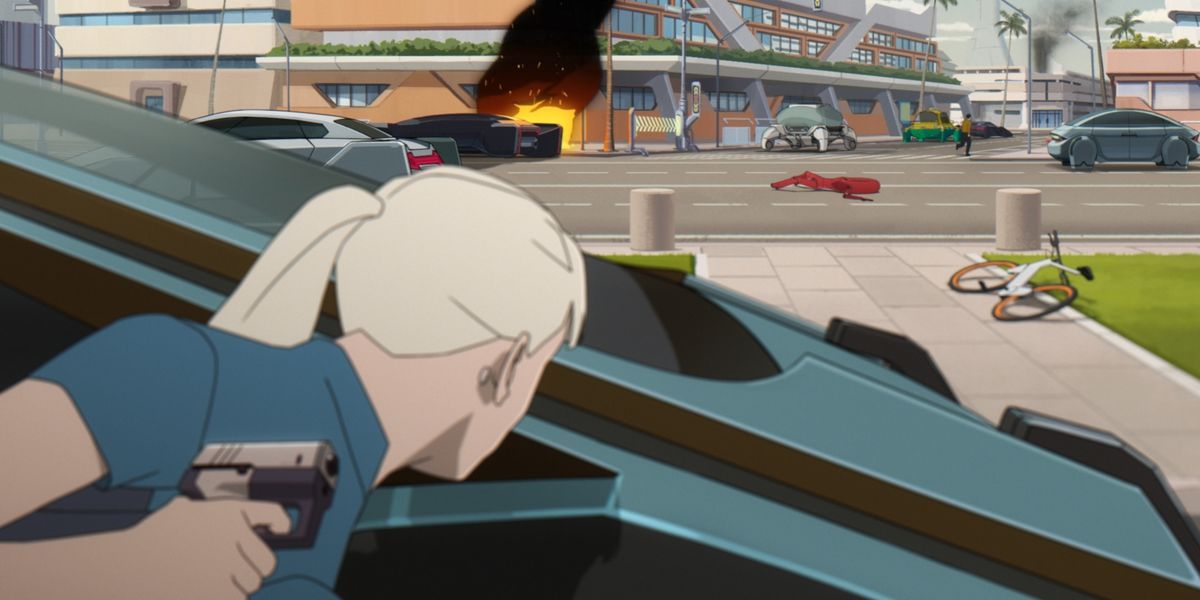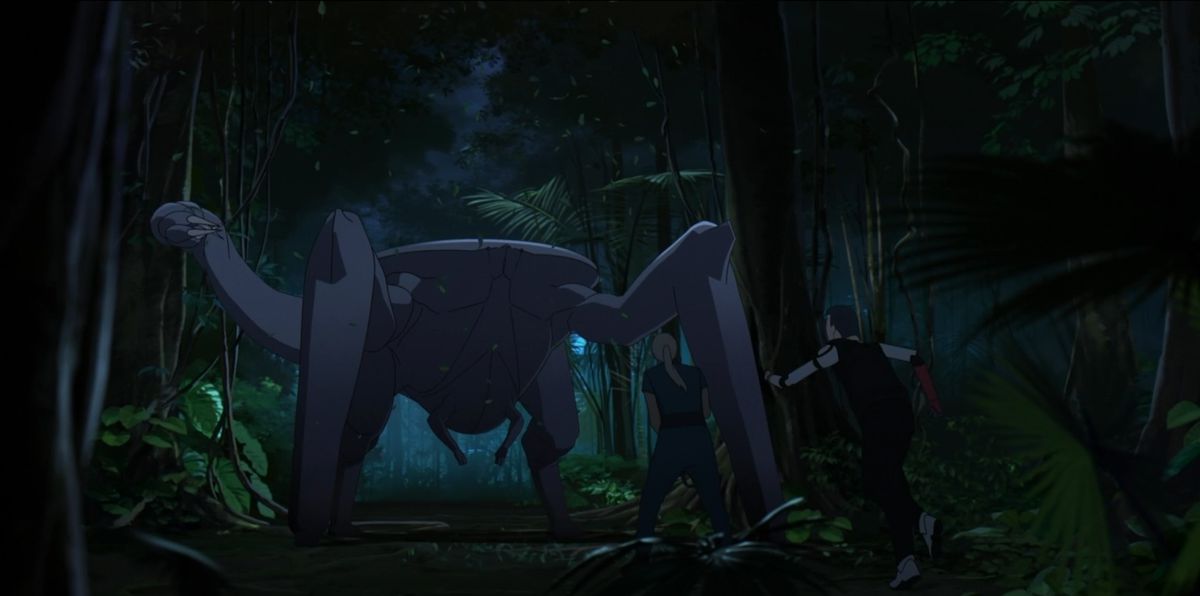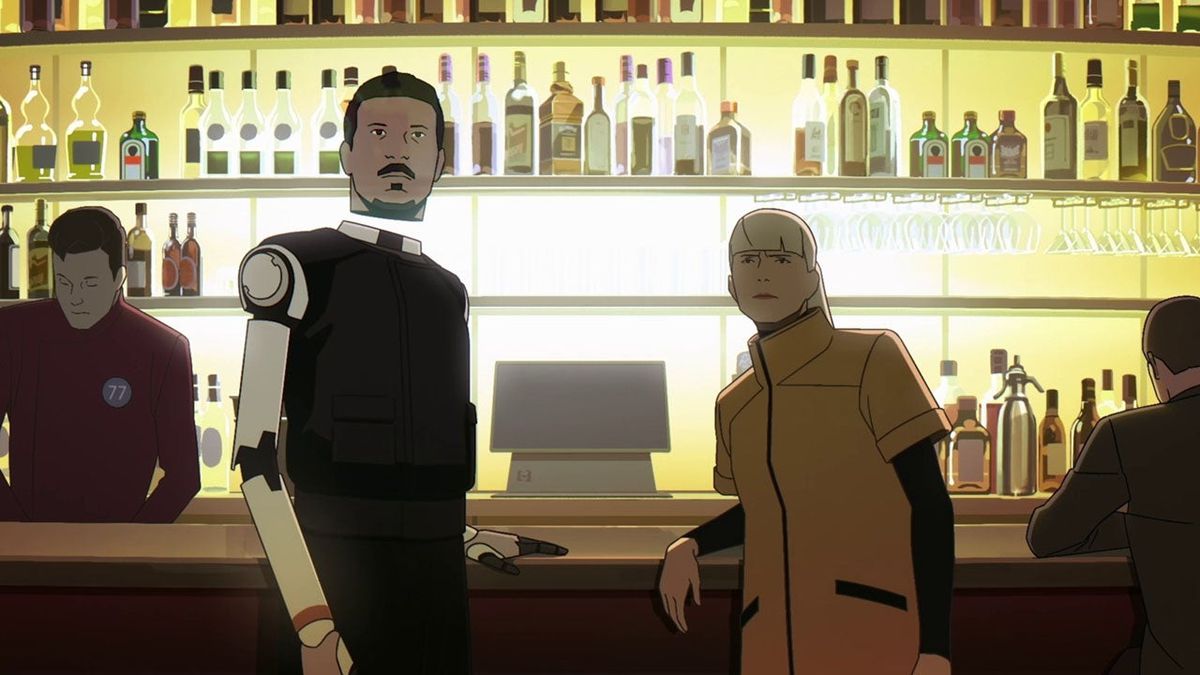Mars Express is the best animated movie of the year you probably haven’t seen or heard about yet. Set in the 22nd century, the film follows a pair of private investigators on Mars hired to track down an elusive hacker on Earth who is jailbreaking robots. Their investigation quickly takes on a different dimension when the disappearance of a college student sets them on the trail of a conspiracy that threatens to upend human-robot civilization as they know it.
Jérémie Périn is a French animator known for directing the 2016 TV series LastMan, as well as several virally popular (and emphatically NSFW) music videos for electronic dance artists like DyE and Lionel Flairs. Mars Express, his first feature, is an outlier not only in his own body of work, but in the French animation industry as a whole: It’s a grounded, hard-boiled detective story set in a universe with a tone and structure that feels indebted to the film noir classics of the past, albeit transposed into a vision of the far future.
Polygon had the opportunity to chat with Périn about the making of Mars Express, which was released on VOD this week, his inspirations from both Japanese animation and classic cinema, and his approach to the outlandish designs behind the film’s robotic and techno-organic characters.
This interview has been lightly edited for length and clarity.
Polygon: Mars Express has a lot of different twists and turns in its story. Were there any particular detective stories or films that inspired you? What are some of your favorite mysteries?
Jérémie Périn: [When it comes to] my favorite ones, we worked on analyzing them, especially in the narrative aspects for the writing of the script. Those movies were Chinatown, The Long Goodbye, Kiss Me Deadly, Point Blank. That kind of movie, those classic PI, film noir. It’s really something I thought that we didn’t have anymore in cinema, not so much. Under the Silver Lake is maybe a movie in that field as well, but it’s not exactly a PI [movie]. It’s more neo-noir.

I really wanted to get back to that figure of the private investigator. But I realized [while working on Mars Express], all the time, they are men. And I was like, What if we put a woman [in the role] instead, to see if there’s some differences? And the fact is, there wasn’t much difference, except with [the absence] of some classic figures, like the femme fatale. We didn’t have any reason to have such a character there, but those inspirations and references were big in my head.
There were other references too. I really enjoy […] Three Days of the Condor, All the President’s Men, The Parallax View, Blow Out, [and Francis Ford Coppola’s] The Conversation. Those movies where someone realizes they’re inside a conspiracy and everything is too big for them.
The influence of Japanese animation feels very prominent in Mars Express, particularly in the way characters move and the larger-scale action scenes in the finale. As a French director, how do you feel Japanese animation differs from French animation, and in what ways did Japanese animation inspire your work on Mars Express?
The methodology of working in Japan and in France regarding animation is different in some specific details, but they are important, especially regarding layouts [more detailed renderings of storyboards that help animators plan and visualize the movement of a shot or sequence before it is animated]. In Japan, animators are doing their own layouts, posing, and their animation. They are responsible for the complete sequence. In France, it’s more split between different teams. There’s a team for layout, there’s a team for animation, and so on. Even the way the animation is played in Japan and France is different.

But as a spectator, I watched a lot of Japanese animation as a child, and even today I continue to watch what they are doing. I realized quickly that they didn’t have the same budget as American animation, or even some French animation. It’s weird because, I feel like there are less drawings in their animation, but at the same time, I feel they are more impactful on me. The feeling of the framing and all that stuff is more powerful to me than a Disney movie, [where] the animation is way more fluid [and] it moves all the time. […] Japanese animation can be very impactful and more cinematic, in my point of view, because they are really efficient in what they are doing [like drawing] but also more efficient [in] the editing and the staging and the depth of the shots.
In the early days of Japanese animation, the action could come from the foreground to the background, and vice versa, to give you a ‘wow’ effect. In more Western animation, it was more like theater, more 2D: You had to see the main character [on the screen] from feet to head and stuff like that. […] To me, all those ideas came from them to compensate [for] the budget and the fact they knew they couldn’t draw as much as a Disney studio [movie]. But little by little, it became a style and a way of narrating their own stories. It became a language in its own way, and in fact, it’s still the language of cinema. They took inspiration from live action also. As a cinemagoer, I love live action as much as animation. So to me, Japanese animation and [live-action film] to me were very influential.
Over the course of the film, we see a lot of what human-robot society looks like on Mars, but we get a glimpse at new types of organic machines and weapons being created by Royjacker, the film’s antagonist. What were your inspirations in creating the look of those creatures?
I don’t know if it’s true or not, but I heard that Google was working on [technology for] skin cells and stuff like that. I was like, ‘Why would a tech society like that work on cells?’ And that gave me the idea that new technologies would do a full circle [in the future]. You know, after making robots look like humans in a synthetic way with plastic and metal, the next step would be coming back to organics like us. It’s more and more close to us, but at the same time, they are monsters.

It’s also a way of making fun of the race [to make] a new product. Like, you have an iPhone and every year, there’s a new iPhone. […] We wanted to make fun of that, like, do we really need a new iPhone every year? [laughs] It was a way to make fun of and talk about planned obsolescence, because that’s what happens to the robots in the movie.
Carlos, the android partner of the film’s protagonist, Aline, is one of the film’s most tragic and fascinating characters. He’s the consciousness of a dead man resurrected inside a machine, who’s trying to hold on to a life that’s moved on without him. What were your inspirations behind creating this character that straddles the line between human and machine?
Yeah, he doesn’t know himself. We came up with this idea because of the story we were building step by step with Laurent Sarfati, my co-writer. At the time we had just one main character, but little by little, we realized the story would be about the emancipation of the robots. It’s their revolution, in a way, and the fact that they are [freeing themselves] from humans.

We knew we didn’t want to do a revolution with violence, like in Terminator when the robots just go ‘Let’s kill all humans.’ We were like, it’s been done already, so let’s try something else. We thought that machines could travel in space more, for obvious reasons, and so we had the ending in mind pretty early on. We [thought] we should have a character that makes the transition from the human perspective, the human point of view, to the robot point of view, and accompany the audience until the end. So thinking about that, Carlos was born. We needed this character that was [both human and robot] just to help the audience understand the robots. At the end we don’t follow them completely, but we needed an insider [perspective] for the ending.
Adult animation isn’t something audiences typically see from French animation, especially original hard science fiction at this scale and quality. Do you believe that Mars Express will open doors for French animators to pursue more mature storytelling, and do you see yourself working in science fiction again?
Definitely yes, I would be into working on another sci-fi movie in the future. The next one I’m working on right now — just as a screenwriter for the moment, I don’t know if this movie will exist in the end, but let’s cross fingers. It’s not exactly sci-fi, but it’s a genre movie. It’s a supernatural thriller. So it’s still weird for French animation anyway. But yeah, I really hope Mars Express will open doors for other people, other directors or other screenwriters to do new sci-fi movies in France, but also any kind of genre movie.
Mars Express is available to rent or purchase on Amazon, Apple, and Vudu.